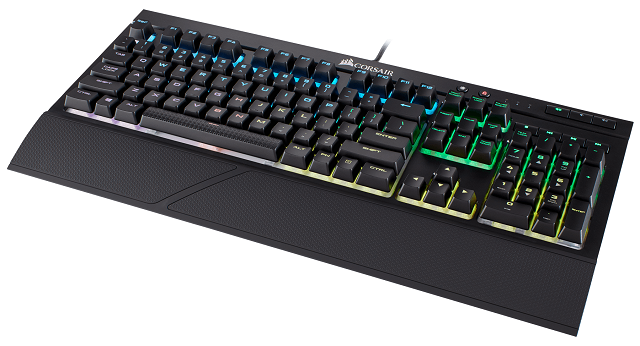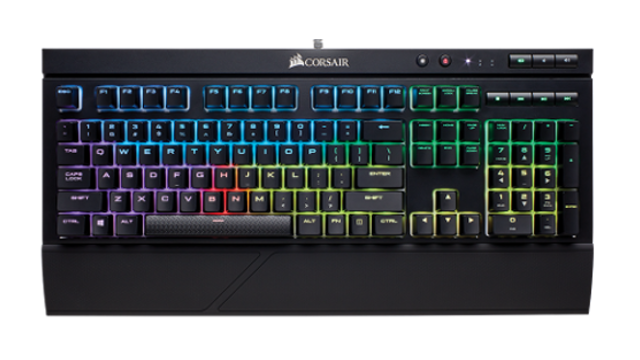Following the pervading trend of colorful, RGB backlighting in modern PC gaming — where almost every peripheral needs the functionality to stay hip — Corsair recently released an RGB variant of their unique, and highly reliable, K68 mechanical gaming keyboard. In our review of the original K68, we gave the keyboard high marks for its innovative design, accuracy, and nearly unbeatable price point.
Fast forward a few months and not a lot has changed for the K68 RGB — what we liked about the original is still here, and some of the same (small) issues are still hanging around. Nonetheless, let’s dive in and take a quick look at why you should consider the K68 RGB if you’re in the market for a mechanical keyboard in 2018.

(Very) Similar in Form and Fashion
For all intents and purposes, the K68 RGB looks identical to the K68 on both the outside and the inside. Sporting the same matte black finish as the original K68, the RGB’s durable hard-plastic chassis looks elegant and refined — especially with the silver Corsair logo emblazoned at the top of the board.
Above the ten-key numpad you’ll find dedicated media playback keys (stop, previous, next, play/pause) and volume keys (up, down, and mute). For the most part, these keys are tight, responsive, and easy to reach. However, just as with the original K68, I often felt that the media playback keys were a bit close to the numpad and could use a bit more room; reaching over the keycaps required a bit of a concentrated effort. To the left of those keys, you’ll find the board’s brightness and Windows lock keys.
Moving on to the main part of the keyboard, you’ll find it’s host to the industry-standard 104 keys. All of the Cherry MX Red switches beneath each keycap employ gold crosspoint technology and are as responsive, accurate, and quiet as you’d expect them to be. Guaranteed for 50 million keypresses, these are your standard Red switches — the ones that are going to last you a long, long time.
Missing are the dedicated “G” keys found on Corsair’s higher-end offerings (which makes sense since this isn’t one of those). But overall, that’s only going to (really) impact MMO and/or MOBA players that need extra keys for standard operations and complex macros. For the average player, omitting those keys from the K68 RGB most likely isn’t a deal breaker.

Water and Dust Resistance for the Win
Like its predecessor, the K68 RGB is also water and dust resistant. It’s hard enough to come across a keyboard that’s “kind of” water and dust resistant, much less one that actually is. And that’s the main feature that sets this board (and its predecessor) apart from other mechanical gaming keyboards on the market.
Implementing IP32 standards, the K68 RGB is able to protect its most vital mechanism from foreign bodies such as water and dust. That doesn’t mean it’s waterproof or dustproof, but it does mean that if you spill water on your keyboard or drop a crumb between the keycaps that the Cherry Red switches beneath will be (much) less prone to malfunction.
How does the K68 do it? Specifically designing the board from the ground up with these type of resistances in mind, Corsair product engineers developed a translucent rubber cover capable of shielding the board’s switches from water seepage and dust particles. On top of that, they manufactured small channels within the chassis to then transport any liquid through the board and safely through small drainage ports on the backside of the board.
It’s something that sets this mechanical apart from the competition.
RGB Backlighting Adds Pizzaz
Whereas the original K68 mechanical keyboard only offered red backlighting, the K68 RGB adds (as its name implies) … RGB backlighting. Using Corsair’s CUE software, you’re able to fully customize the backlighting and lighting patterns of the K68 RGB — down to each individual key.
As is basically standard in the industry these days, you’ll have access to the entire RGB spectrum of 16 million-plus colors so that you can program any hue you desire — down to the exact shade if that’s your thing. On top of that, Corsair provides 11 distinct lighting patterns, from spiral to rain and more. You can even select the speed at which patterns oscillate and in which directions they move about the board.
Each of these presets — and any you come up with yourself — can be programmed to the board and easily recalled at any computer, regardless of if CUE is installed on the device or not.
Verdict
It’s curious that full RGB backlighting wasn’t a feature on the original K68 since the only real distinguishing factor between this board and its predecessor is that functionality. But I suppose we expect options these days, so here we stand.
Like its progenitor, the K68 RGB features reliable Cherry MX switches (the board currently comes in both the Red and Blue variety, but we only tested the Red variant), unique water and dust resistance, fully customizable macros, 100% anti-ghosting tech, and NKRO. It’s comfortable and reliable, providing pro-level capabilities in a compact frame.
At any rate, it’s a mechanical keyboard well worth considering if you’re a casual or competitive player. Just know that if you spend hours ulting noobs in the mid lane or grinding in preparation for high-rank raid, one of Corsair’s more robust, higher-tier offerings may be what you’re looking for.
Coming in at $119.99, the K68 RGB isn’t the most expensive board out there. In fact, I’d say that its price tag is well-deserved for what you get. However, being that the K68 provides all of the same functionality of the K68 RGB sans RGB lighting for $89.99, you have to ask yourself: Is having access to 16 million colors worth the extra $30?
You can buy the K68 RGB on Corsair’s website.
[Note: Corsair provided the K68 RGB used for this review].







Published: Feb 7, 2018 09:29 am